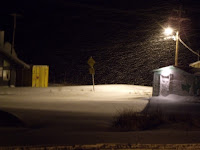I said I’d try to be better at posting this year. But...I’m not. Oh well. Things are really busy up here with my teaching load. This year, I’m teaching primarily math and science. If you don’t know anything about the No Child Left Behind law, you have to be Highly Qualified to teach a subject within a year of teaching it. I took the 7-12 Math Praxis last year, and scored high enough to become Highly Qualified in the state of Alaska (not high enough for the state of Colorado though). So, this year, I’m teaching the following schedule:
- 1st Period - 9th and 10th Grade math (Algebra I and HSGQE Math...HSGQE = High School Graduation Qualifying Exam)
- 2nd Period - Subsistence Issues Elective
- 3rd Period - 6th/7th/8th Grade Biology
- 4th Period - High School Biology
- 5th Period - 6th/7th/8th Grade Math (This is actually 3 separate curriculums) and Algebra II
- 6th Period - 11th and 12th Grade math (Algebra II, HSGQE Math, and College Math)
 |
| Friday Morning Snow |
So, on top of all of that, once a quarter, we (the middle/high school teachers) go around to all the students’ houses to deliver progress reports. We visit with the families to tell them how their kids are doing in a less intimidating environment than the school. Also gives them a little warning for their student to be able to fix their grades before report cards come out. We try to visit with every students’ parents or guardians. It takes a few hours, but the community seems to really appreciate it.
 |
| Snow! Finally! |
Sports are also in full swing here. Right now, we’re right at the end of wrestling and volleyball season. Because there are obviously no other high schools nearby, our team travels by plane. Regions were this weekend for both sports. The teams were supposed to leave on Wednesday afternoon, but we had a storm system move in. They both ended up leaving on Thursday morning. Hopefully they’ll all be back tomorrow (Sunday). The volleyball tournament was in New Stuyahok, which is the village just south of us. Because it’s “close,” almost the entire village went to watch. By lunchtime on Thursday, we had 7 high school students and 8 middle school students left in school. It makes teaching a little difficult when all your students are missing.
 |
| Footsteps in the "small" drift |
We FINALLY got a big snow! It had been starting to feel like springtime up here...rainy and “warm.” But Thursday brought some snow...and Thursday night brought even more! I walked out of my house Friday morning with my snow boots and only saw a few inches on my front steps. So I figured I’d be okay. I rounded the first corner and saw that the wind and made drifts in front...but they only looked to be 9-12 inches. Just boots should be okay. Stomp Tromp Stomp. Round the second corner. Oh man! Drifts up past my knees! Crap! Turn around, head down, disheartened...back to the house for my ski pants. Other than tromping through the snow to work, everyone is really happy about the snow.














